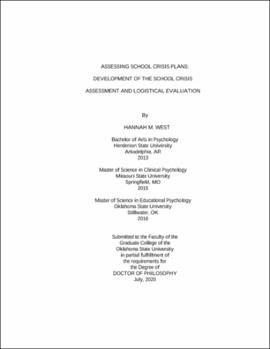| dc.description.abstract | A crisis is defined as an event that is viewed by the person experiencing it as extremely negative, uncontrollable, and unpredictable (Brock et al., 2016). Children and adolescents spend a large percentage of their time in schools, and for this reason, schools must be prepared and ready to respond to any number of crisis situations (Brock et al., 2016; Gainney, 2010; Gray & Lewis, 2015). Schools must be actively preparing for school crisis, starting with the development of a comprehensive crisis plan, because there are only two types of schools - those who have faced a crisis event and those who are about to face one (Stephens, 1994). The current study developed a rubric tool for the evaluation of school crisis plans based on a review of the existing crisis plan checklists and the research base, along with feedback and suggestions from a panel of school crisis experts. A total of 48 school crisis plans from across the United States were evaluated using the School Crisis Assessment and Logistical Evaluation (SCALE) to assess the comprehensiveness of school crisis plans. The results indicated strong inter-rater reliability, with an agreement percentage of 89.49%. Additionally, the Fleiss' kappa demonstrated strong agreement between raters' judgments, K=.856 (95% CI, .834 to .879), p < .001. In regard to intra-rater agreement, the absolute agreement percentage was 80.57%. These results provide preliminary support for the use of this measure to provide an initial assessment of school crisis plans, as well as for the use as a progress monitoring tool. Further, analysis indicated that overall, school crisis plans were often lacking recommended components in the prevention, intervention, and postvention areas. These results hold several implications for schools. First, schools should be revising and updating crisis plans on a regular basis. The SCALE shows promise as a tool to identify current levels of school crisis plan content and to assist in monitoring changes made over time. Future research should continue to examine the usability of the SCALE and to ensure implementation of best practices when faced with crisis situations. | |
